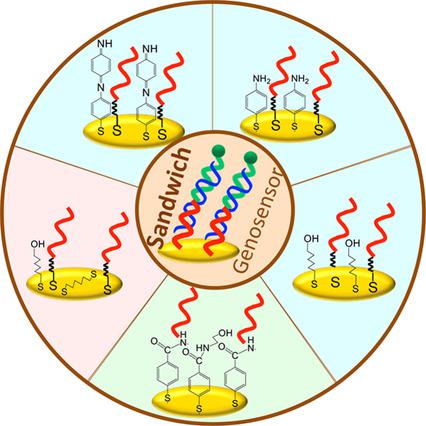当前位置:
X-MOL 学术
›
Electroanalysis
›
论文详情
Our official English website, www.x-mol.net, welcomes your feedback! (Note: you will need to create a separate account there.)
Understanding the Factors Affecting the Analytical Performance of Sandwich-Hybridization Genosensors on Gold Electrodes
Electroanalysis ( IF 3 ) Pub Date : 2018-02-28 , DOI: 10.1002/elan.201800049 Rebeca Miranda-Castro 1 , Noemí de-los- Santos-Álvarez 1 , María Jesús Lobo-Castañón 1
Electroanalysis ( IF 3 ) Pub Date : 2018-02-28 , DOI: 10.1002/elan.201800049 Rebeca Miranda-Castro 1 , Noemí de-los- Santos-Álvarez 1 , María Jesús Lobo-Castañón 1
Affiliation

|
Hybridization-based electrochemical DNA sensors have become a methodological mainstay in a wide variety of fields. Among the possible assay formats, sandwich hybridization is the most powerful one. It is so called because the target sequence to be measured is hybridized between two complementary sequences. The analytical performance of this class of sensors is influenced by many construction and operational parameters, which need to be optimized. In this work, we comparatively analyze the analytical performance of different sandwich hybridization sensors, constructed on gold surfaces modified by chemisorption. We find that the structures of the designed probes as well as the topography of the gold support and the nature of the monolayer are key parameters affecting the sensitivity and reproducibility of the genosensors. Other important operational parameters are also described. The results of this study could serve as a guide in the design of genosensors for future applications.
中文翻译:

了解影响金电极夹心杂交基因传感器分析性能的因素
基于杂交的电化学 DNA 传感器已成为各种领域的方法论支柱。在可能的检测形式中,夹心杂交是最强大的一种。之所以这样称呼,是因为要测量的目标序列是在两个互补序列之间杂交的。此类传感器的分析性能受许多结构和操作参数的影响,需要对其进行优化。在这项工作中,我们比较分析了在化学吸附改性的金表面上构建的不同夹心杂交传感器的分析性能。我们发现设计的探针的结构以及金载体的形貌和单层的性质是影响基因传感器灵敏度和再现性的关键参数。还描述了其他重要的操作参数。这项研究的结果可以作为未来应用基因传感器设计的指南。
更新日期:2018-02-28
中文翻译:

了解影响金电极夹心杂交基因传感器分析性能的因素
基于杂交的电化学 DNA 传感器已成为各种领域的方法论支柱。在可能的检测形式中,夹心杂交是最强大的一种。之所以这样称呼,是因为要测量的目标序列是在两个互补序列之间杂交的。此类传感器的分析性能受许多结构和操作参数的影响,需要对其进行优化。在这项工作中,我们比较分析了在化学吸附改性的金表面上构建的不同夹心杂交传感器的分析性能。我们发现设计的探针的结构以及金载体的形貌和单层的性质是影响基因传感器灵敏度和再现性的关键参数。还描述了其他重要的操作参数。这项研究的结果可以作为未来应用基因传感器设计的指南。



























 京公网安备 11010802027423号
京公网安备 11010802027423号